Local people use the threads of the Golden orb web spider for fishing, because its web is very strong. The web's golden colour deceives bees and insects and draws them into it.
Your god is God alone, there is no other deity than Him. He encompasses all things in His knowledge. (Surah Ta Ha: 98)

Spiders' thread is five times stronger than steel of the same thickness, and can stretch to four times its own length.
Everybody knows that spiders use silky threads produced from their own bodies in order to spin webs. But the stages of production of the thread and its general features are not so well known. The thread produced by spiders, of a diameter less than one thousandth of a millimetre, is five times stronger than a steel thread of the same dimensions. It can, moreover, stretch to four times its own length. Another striking feature of the silk is that it is very light. We can demonstrate this with an example. A silk thread stretching around the whole world would only weigh 320 grams.20
It will be worth having another look at the above technical details. We cannot just gloss over the fact that the silk is five times stronger than steel. Because steel, known for being one of the strongest materials in the world, is an alloy produced in large factories in a series of processes. Spiders' silk, however, five times stronger than steel, is not produced in large factories: it is made by an arachnid. Just about any spider we can see anywhere can produce it. Steel is a heavy material, for which reason it is difficult to use. It is produced in large furnaces at high temperatures and is prepared for use by cooling in moulds. In contrast, spiders' thread is very light. It is produced in the spiders' own small bodies, not in giant furnaces and moulds.
Another miraculous aspect of spider thread is that it is very elastic. It is very difficult to find a material both strong and elastic. For example, steel cables are one of the strongest materials around. But because they are not elastic like rubber, they slowly lose their shape. And although rubber cables do not lose their shape, they are not strong enough to lift heavy weights. On the other hand, as has been described above, spider silk is five times stronger than steel wire of the same thickness, and 30 percent more elastic than rubber of the same thickness.21 To put it in technical terms, spider thread, from the point of view of its resistance to breaking and the extent it can stretch before breaking, is a material the like of which does not exist.
The research into spiders carried out over the last few decades, and the information resulting from it, has brought with it several questions. For example, if mankind makes steel and rubber cables as a result of the knowledge gathered over hundreds of years, then with what knowledge is spider thread, which is so superior, made? How is it that mankind cannot fully grasp the formula and put it into operation? What is it that makes spider silk so superior? The answer is hidden in the construction of the silk. Research by international chemical manufacturing companies has only partially determined the make-up of spider thread.
 |  The "wolf spider" prepares a matchless cocoon for its eggs. The hard exterior of the cocoon protects the eggs from external dangers. The inside, padded with silk, provides maximum comfort. The spider inserts the eggs through a hole in the top of the sack. (Top) Then it closes up the hole and the eggs enjoy perfect armoured protection. One species in Oklahoma makes a padded nest for itself. It finds a leaf and carries it in its mouth. It folds the leaf up and joins the edges with a special silk. (Side) To guarantee the comfort of the nest, it lines the inner walls with silk. |
The silk spiders make is much stronger than any known fibres, natural or synthetic. When scientists realised this they began experimenting to understand in what way spiders make it. The first ones thought this would be as simple as getting silk from silkworms, but later it dawned on them they were wrong.

Ptocasius is a species of spider which joins two leaves together to make its nest. It uses its silk as glue to join the leaves together. This nest enables it to hide at night and when hunting.
Evolutionary zoologist Fritz Vollrath, of Aarhus University in Denmark, realised, as a result of his research, that it would not be possible to make it by taking it directly from spiders. This being the case, scientists then came up with the idea of "the production of artificial spider silk" as an alternative. But, before that, it was necessary for the researchers to find out how the spider produces the silk. This took quite a few years. The zoologist Vollrath discovered an important part of the method in his later work. The spiders' method is remarkably similar to the process used to manufacture industrial fibers such as nylon: spiders harden their silk by acidifying it. Vollrath concentrated his work on the garden cross spider known as Araneus diadematus and examined a duct through which the silk flows before exiting. Before entering the duct, the silk consists of liquid proteins. In the duct, specialized cells draw water away from the silk proteins. Hydrogen atoms taken from the water are pumped into another part of the duct, creating an acid bath. When the silk proteins make contact with the acid, they fold and form bridges with one another, hardening the silk.22 But of course the formation of the silk is not as simple as described here. For silk to emerge, other materials and sacs of various properties are needed.
The raw material of spider silk is "keratin," a protein that appears as braided, helical strands of amino acid chains. This material is also found in hair, horn and feathers. The spider obtains all the raw materials for its silk from a synthesis of the amino acids it secures by digesting its prey. Spiders also eat and digest their own webs, thus producing inside their own bodies the material for further web production.
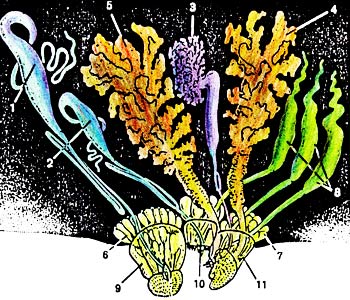
It is enough to examine their silk glands to realise that spiders could not have emerged by coincidence. This picture shows the glands on the Madagascar spider's (Nephila Madagascariensis) right side. There are glands on the left side as well. Silk glands 1 and 2 produce the dry silk the spider holds on to when walking on its web, or when climbing up and down. The viscid silk is produced in another gland (3). This basic silk is coated by the adhesive (sticky) glands (4 and 5). The 6th gland produces the adhesive necessary for sticking the silk to another surface. The 7th gland produces the raw material for a special thin silk used to wrap the prey up after it is caught. The 8th gland produces the silk for the cocoon. 9, 10, and 11 show the back, central, and front spinnerets (silk nozzles). Spiders make their silk by means of this peerless system. It is clear that this system, with its different structures and functions, could not have come about by coincidences. Spiders were created together with this system by the Almighty God.
There is an area at the base of the spider's abdomen where the silk glands are found. Each gland produces different elements. Different types of silk threads are produced from different combinations of the elements from these glands. There is a great conformity between the glands. During the silk production process, specially well-developed pumps and pressure systems within the spider's body are used. The raw silk produced is thrown out in the form of fibres by spinnerets (nozzles) which function like taps. The spider can alter the spray pressure within these spinnerets as it wishes. This is an especially important feature. Because in this way the make-up of the molecules which form the raw keratin is changed. By the use of the control mechanism in the valves the diameter, resistance and elasticity of the thread can be altered while it is being produced. Thus the thread can take on the desired physical characteristics without the need for a change in its chemical composition. If any greater change to the thread is desired, another gland has to come into operation. The resulting tiny silk threads with their many features are then set in the desired way by expert use of the rear legs.
The ratios in which the products of six different glands are mixed are of the utmost importance. For example, when the sticky thread is being produced, if that material which gives the sticky quality is not used in sufficient quantities, it will lose the ability to catch insects. If it is used in too great quantities, the usability of the web will be reduced. For the thread to serve its purpose, the products of the other glands must necessarily be applied at the right level.
The result of these processes being successfully completed is spider silk, with its properties, all different from each other, and able to serve different functions. Spider silk is so strong that Vollrath, the zoologist, describes it in these words: "Spider silk is stronger and more elastic than Kevlar, and Kevlar is the strongest man-made fiber."23
And these are not the only special qualities of spider silks. Unlike Kevlar, a kind of plastic used in the production of bullet-proof jackets because of its strength, spider silk can be recycled and used again and again.
The most important point here is that this most perfect product in the world, stronger than steel and more elastic than rubber, is made in the body of the spider. Even the largest textile factories, the most developed weaving establishments, and chemical laboratories fully equipped with the latest technology and researching into atoms have been unable to manufacture anything quite like spider silk. So how did a spider plan such an incomparable chemical make-up? After having planned it, how did it identify the source of the raw materials necessary for production and how did it settle on the six basic ingredients? What measuring equipment did it use to establish the proportions between them?

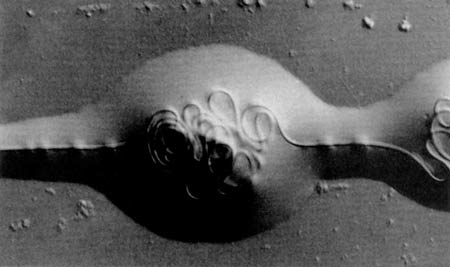
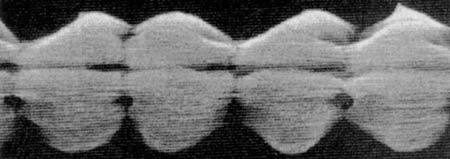
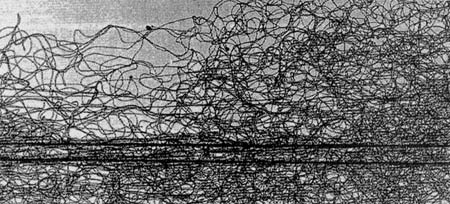
The picture on the top shows the capturing thread of an ecribellate spider, such as A. diadematus, magnified 100 times. The aqueous coat which gives the thread its sticky quality is seen here as minute droplets. In the second picture, magnified 300 times, are seen rolled threads like cable balls. Surface tension within each drop causes core fibers to bunch up, creating a windlass system, shown in its contracted state. Under pressure the system relaxes and the thread can stretch to a great extent. As will be seen from the 200 times magnified picture (third picture), this dry thread (cribellate spider thread) is formed by the coming together of hundreds of micro dry threads. These silks are already sticky without being coated in any liquid. The stickiness comes about thanks to the combing operation the spider employs when spinning its silk. This operation, done through a fine comb located on the shin of the hind leg, enlarges the threads. This swelling up can be seen only under 1000 time magnification and the elecrostatic effect created gives the thread its trapping quality. It is not possible for these flawless properties to have come about as the result of coincidences, as the evolutionists claim. God created the spider, together with this wonderful system.

(1) FLA GELLIFORM GLAND
(2) AGGREGATE GLAND
(3) CYLINDIRICAL GLAND
(4) MINOR APPULLATE GLAND
(5) TOUGH OUTER SILK OF EGG SAC
(6) MAJOR APPULLATE GLAND
(7) ACINIFORM GLAND
(8) PIRIFORM GLAND
(9) CORE FIBERS OF CAPTURE SPIRAL
(10) AQUEOUS COATING
(11) AUXILIARY SPIRAL
(12) DRAGLINE
(13) STRUCTURAL SILK
(14) CEMENT FOR JOINTS AND ATTACHMENTS
(15) SOFT INNER SILK OF EGG SAC
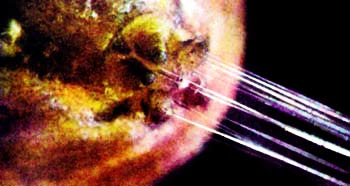 | Every spider produces silks with different properties for different functions. The spider known as A. diadematus can switch between silks with varied amino acid compositions. The spider uses abdominal glands and spigots to produce seven kinds of silk. These threads, stronger than steel and more elastic than rubber, made of one of the most perfect materials in the world, are produced in the spider's body. This is God's art. God is He Who created everything and Who is Aware of all creation. |
There is no doubt that all of this could not have come about by chance, as the evolutionists maintain. The spider cannot create a new system within its own body. It is not possible for it first to identify what it will need and then locate them inside its own body. Such an idea is far removed from the realms of science and logic.
It is definitely not possible for a system which produces silks with all their different features to have come about by itself. Such a claim is simply nonsense.
Of course God, Creator of the heavens and the earth, also created the spider and this superb system. God it is Who creates everything flawlessly and Who is aware of all creation.
...He has no partner in the Kingdom. He created everything and determined it most exactly. (Surat al-Furqan: 2)

(1) The thread of the tear-resistant cocoon.
(2) The elastic sticky thread of the capturing spiral.
(3) The less elastic spiral thread the spider walks on.
(4)The less elastic, almost rigid thread which makes up the frame of the web.
(5) The thread of the tear-resistant cocoon.
(6) The soft thread used for wrapping eggs and prey.
Every species of spider has its own way of spinning and using webs. But they all employ the same perfect thread-production mechanism. God has created in spiders a system which is flawless in every way.
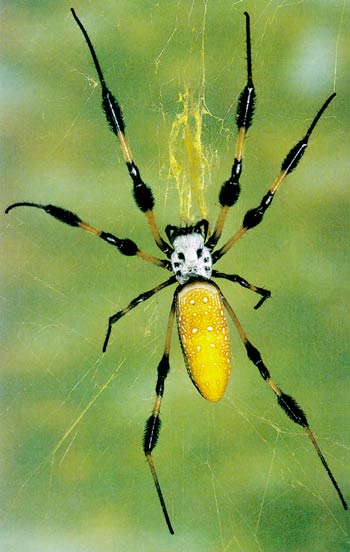 Local people use the threads of the Golden orb web spider for fishing, because its web is very strong. The web's golden colour deceives bees and insects and draws them into it. |
It is not widely known that spiders use more than one type of thread when spinning their webs. Actually, spiders make different threads in their bodies for different purposes. It is obvious what an important characteristic this is when we consider spiders' lives. For it is essential that the threads the spider walks about on, and those it uses to catch its prey or to wrap it up tightly, should be different from one another. For example, if the thread which the spider walks about on were as sticky as that which it uses when hunting its prey, then the spider would also get stuck in it, and that would lead to its death.
Let us consider an example. All spiders produce and use a variety of silks, but the orb-weaving Araneid spiders appear to make the most diverse use of them, and they produce the most familiar silken structure, the orb-web. These spiders produce at least seven silks. These are, first, the silk which constitutes the frame and radii of the orb-web and the dragline upon which the spider lowers itself; and second, the viscid silk which is used to form the catching spirals of the orb-web. In addition, the spider produces a glue to coat the spiral silk;accessory fibres that apparently reinforce the frame and dragline silks; cocoon silk; a silk to wrap captured prey; and a silk to attach the frame and dragline silks to the substrate.24
These silks, in the same way as they have different qualities from the point of view of strength and elasticity, also exhibit different thicknesses and levels of stickiness. For example, although the dragline, which plays such a large part in the spider's life, does not possess the quality of stickiness, it is nevertheless strong and elastic. It can easily bear weights up to two or three times the weight of the spider. It is thanks to this silk that the spider, carrying the prey it has caught, can move safely up and down.
As we have seen, in order to live, the spider needs to be able to produce different types of silk and also to know where to use each one. For even one of these to be lacking would mean death to the spider.
It would not be possible for a spider to survive without possessing all of these at once. Imagine a spider which spun perfect webs to wonderful designs but whose webs were not sticky. This would render the spider's web completely useless. It is not even an option for it to wait thousands of years for the process of evolution to teach it how to make sticky webs, because without this knowledge the spider would be dead within a few days. Or imagine a spider which could produce all kinds of silk but was unable to make a web. Of course the silks it made would be of no use at all and again it would die. Even if it was able to produce all the silks, but not the cocoon silks to protect its eggs; in that case the spider would die out. As has been demonstrated, spiders have never had the time to acquire all the characteristics which they possess with the passing of time as the evolutionists claim.

ÇELİKTEN SAĞLAM iPLİK
Enlargement of spider thread (a) shows it to be a composite material made of strands of disordered amino acid chains and ordered crystals (b and c). Each crystal is made up of different-size amino acid groups pressed into an accordionlike formation, called beta-pleated sheets (d). The surrounding strands are called alpha helixes;their contracted disarray provides silk with its elasticity. When silk is emitted, shearing forces like those shown at the right (e) are applied to some alpha helixes. Consequently, their hydrogen bonds break and they become beta-pleated sheets. (f), as the similarity of the highlighted molecular strands shows. (1 nanometre= 0.000000001 meter).
Not one iota of the features which spiders possess can have come about in stages as claimed by the theory of evolution. From the time of the very first spider on Earth, all spiders have had to exist in complete form. All of these facts are evidence that spiders emerged at one time, in other words, that they were created by God. By means of this miracle of creation in the spider, God is showing us His limitless power and knowledge.
The thread shows different features, depending on what the spider will use it for. For example, the sticky threads are produced in different glands from the dragline and are thinner and more elastic. In some situations they can stretch 500-600 percent.
Spiders have a pump-and-valve system that enables them to make threads. Glandular ducts thicken the substance they exude into a highly vicious state:a liquid crystal, in which the molecules are organized in parallel lines. Strong shearing forces applied to the emergent thread by an extrusion nozzle cause many of the alpha chains to form a stable, tertiary structure, called a beta-pleated sheet.
These protein crystals are in turn embedded in a rubberlike matrix composed of amino acid chains that are not linked into beta-pleated sheets. Instead these helical strands are tangled up in a state of high entropy. It is precisely this randomness that lends silk, like rubber, exceptional elasticity. Stretching the thread pulls the protein strands out of disarray - which they resist - whereas releasing the thread allows them to contract back into blissful disorder.25
The elasticity of the sticky threads makes it possible for flying insects to be gradually brought to a stop. In this way the danger of the web breaking is reduced. The sticky substance used is produced in another group of glands with different functions. This material is so adhesive that it is impossible for insects which get caught in the web to escape.

The tiny drops on the surface of the thread are seen here.
The spider's silk is a scleroprotein which is emitted from the spinnerets as a liquid. Scleroprotein is a type of protein that hardens into a tough elastic structure in contact with the air. Thanks to this protein the silk is extremely strong. So strong and resilient has spider silk proved that, on the human scale, a web resembling a fishing net could catch a passanger plane.26
Silk's elasticity is balanced by its strength. Because it is a composite material, like glass fibers embedded in a resin, silk is strong. Its crystals and matrix resist breaking. A stretched thread usually snaps because a crack on the surface cuts into it like a wedge. Forces acting along the fiber concentrate at the crack and cause it to rip with increasing speed ever deeper into the material. Such cracks, however, can travel only if they do not encounter resistance. The crystals in the rubber matrix of the spider silk provide obstacles that divert and weaken the rending force.27
For something under tension even minor damage to the surface can be dangerous. But this risk is avoided by a precautionary measure in spider thread. While the garden spider spins its silk, it coats it with a liquid material at the same time, in such a way that any cracks that might appear on the surface of the silk are avoided. This method, which spiders have been employing for millions of years, is used in today's industrial cables, which bear heavy loads and need to be very strong.
The descriptions given so far have been technical ones of an existent miracle of construction. But now we must stop and think. What is the truth underlying these technical explanations? It is obvious that the spider is unaware of proteins and the crystal states of the atom. It also knows nothing about chemistry, physics, or engineering. It is a creature bereft of the capacity of thought. But as for the features it possesses, it is impossible for these to be explained by means of chance. But in that case, who is it who makes all these plans and calculations? As we study the spider's web and silk, and its ways of hunting and living, it is immediately clear that it could not have brought about this flawless technical operation all by itself.
Any spider we can see at any moment in a hidden corner or among the plants in a garden is, with its concentration of chemical, physical and architectural capability, yet another clear proof of God's art of creation. In this living creature God is revealing to us His limitless wisdom, His infinite power of creation. It is God Who inspires everything the spider does. God announces this truth in the Qur'an:
Everything in the heavens and the earth glorifies God. He is the Almighty, the All-Wise. The kingdom of the heavens and the earth belongs to Him. He gives life and causes death. He has power over all things. (Surat al-Hadid: 1-2)
Garden spiders use a strut to strengthen their nests. In its web the spider stabilises the outermost spiral thread with 4 to 6 holding points and suspends it vertically to catch insects in flight. Apart from this, spiders fix a weight on to the lower half of the outermost spiral thread from another short thread in such a way as to make it taut. This weight, which makes the web strong and swings in the air, may be a small stone, or a piece of wood, or a snail shell. Scientists have observed that when they gently lift the weight hanging from the web without releasing it and stopping it swinging, the spider waiting in its nest immediately emerges and checks it. Then the spider shortens the thread in order to let the weight swing free again. The results of these observations have established that all this is done by the spider with the aim of strengthening the web.28
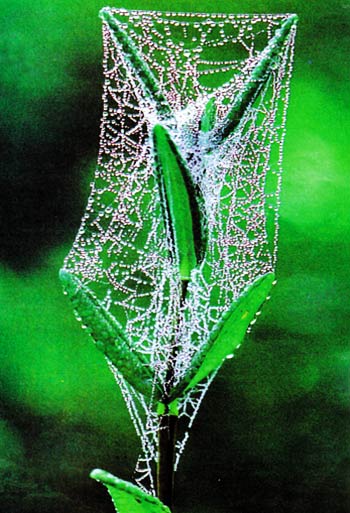 Prey caught in a spider's web can do little about it. The trap is prepared so expertly that, as the victim struggles, the web loses elasticity and grips the prey even tighter. As a little time passes and the victim becomes completely powerless, the web grows stronger and tauter than before. In this way the spider, watching the creature's hopeless struggle from a corner somewhere, can easily kill the trapped prey, which is now exhausted.
Prey caught in a spider's web can do little about it. The trap is prepared so expertly that, as the victim struggles, the web loses elasticity and grips the prey even tighter. As a little time passes and the victim becomes completely powerless, the web grows stronger and tauter than before. In this way the spider, watching the creature's hopeless struggle from a corner somewhere, can easily kill the trapped prey, which is now exhausted.
What one would expect when a victim gets stuck in a web is that, as the insect struggles, the web is pulled out of shape and the creature escapes from the trap. But exactly the opposite happens and the web grows stronger, completely immobilising the insect. How can a web increase in strength as the victim caught in it struggles?
The answer to this emerges when we examine the structure of the web. The spider's capturing threads take on a new form due to the moisture of the air. The change happens like this. The garden spider's spiral threads are formed by the coming together of two liquid-covered fibres. This adhesive liquid is produced in a different gland from those which produce the basic fibres. The silk threads which emerge from the spider's spinning glands are continuously coated in a film of this sticky material. The source of the adhesive nature of this material is the glycoproteins it contains. Furthermore, it consists of 80 percent of that economic material, water.29
As the sticky liquid comes into contact with the water in the air it separates into tiny drops which attach themselves to the thread like little beads. Contracting and stretching the sticky thread in rapid succession wind and unwind the core fibres inside the droplets. Thus, the entire system of core fibers and coating is always under tension, keeping the sticky thread taut. Energy applied by buffeting winds or blundering insects is not absorbed by the silk itself but by the entire system.
The core fibers do their share of the work as well. Plasticized and therefore essentially like reinforced rubber, they benefit directly from the fact that entropic elasticity is temperature dependent. Because the kinetic energy of the prey is largely converted into heat, the thread warms up. The heating increases entropy, and consequently the core fibers grow stronger. The absorbed energy of the prey actually strengthens the capturing thread and does so only because of the spider's clever trick of applying aqueous coating.30 On account of these features the spider's web is the most pitiless trap in nature.
One may wonder whether these features are present or not in other silken threads. What would happen if that were the case? For example what would happen if load-bearing threads had the same stretching capacity? Of course it would be quite difficult for the spider to carry itself or its prey. In fact, the load-bearing silks, which make up the skeleton of the web, in contrast to the catching threads, are coated in another substance which protects them from water, because it is not necessary for the load-bearing threads to be as elastic as the adhesive ones.
As has been seen, the spider makes coatings of different substances for silks of various functions and construction as and when necessary. Right, so how does the spider know about the coatings' different physical and chemical effects? To maintain that the spider was trained, or came by them by experience or coincidence flies in the face of intelligence and common sense.
At this point just a little thought is sufficient to find the true answer. In order for the spider to be able to plan all this, it would first have to learn all the molecular structures, and the chemical mechanisms which cause the liquid to solidify as we have described above. Then after learning all this, it would then have to decide to go into production. After reaching that decision it would then have to bring about certain changes within its own body and set up the systems to make all these products.
This, of course, is an imaginary scenario. As we have seen, the perfect planning of the spider's body and its purposeful behaviour cannot be explained by any event in nature or any other force. That the spider was unable to do all of this for itself is a fact that any intelligent person can see. It is not possible, therefore to explain the spiders' purposeful behaviour and physical structure by changes over time or any other evolutionary process.
All living creatures in nature have characteristics similar to, or even more detailed, than those of the spider. Observing any one of them will suffice to confirm the obvious planning in these living creatures. The existence of a force which governs all of them is quite clear. Their physical planning, or else their behaviour prove that these living things were made by a creator, in other words, by God. It is enough to use our intelligence to see this. God, the Lord of all the worlds has announced this fact to mankind with His verse, '(He is) The Lord of the East and the West and everything between them. If only you used your intellect.' (Surat ash-Shu'ara': 28)
A material's strength and elasticity are of great importance in the industrial sector. Strength widens the field in which it can be used, and elasticity increases the ease with which it can be applied. From the point of view of strength and elasticity, spider thread is the most perfect material in the world. For this reason researchers greatly increased their studies of spider silk in the last quarter of the 20th century. As a result of these they have been able to produce by chemical means only something resembling spider silk but of much poorer quality. In short, modern technology, despite all its resources and research, has been unable to produce a thread with qualities equivalent to that which the spider makes.
Spider thread is a protein principally consisting of the amino acids glycine, alanine, serine and tyrosine. The Du Pont company has produced various synthetic fibres by unearthing the chemical formula of the silk and determining the order in which the molecules which make it up lie. Every giant molecule in this synthetic polymer is made up of thousands of molecular chains of carbon, oxygen, nitrogen, and hydrogen atoms. This product, known as "Kevlar," today produced artificially, is the most developed of organic fibres. With their strength and elasticity, Kevlar synthetic fibres come closest to the physical characteristics of spider silk.
Kevlar is used in car seat-belts and in various items of protective clothing. It is an important product also used to large degree in the aircraft and shipping industry as an external material, in the production of fibre-optic and electro-mechanical cables, in the rope and cable industry, and in various sports implements.
Kevlar fibres are made from "poly-paraphenylene terephthalamide." This fibre, consisting of long molecular chains, is suitable for bending and using as a thread thanks to its construction. Its properties of durability and lightness have led to this material being used in many areas of industry.
One of the most important fields in which Kevlar has been utilized in this century has been the defence industry. Bullet-proof vests, which used to be made from steel, are now made from fabrics woven from Kevlar fibres, which look no different from ordinary cloth. Kevlar, thanks to its shock-absorbing properties, reduces the bullet's force of impact. This is a most important discovery from the technological point of view, as well as being a most useful one. Yet despite these excellent properties, Kevlar fibres' shock-absorbing properties are only one-third of those of spider silk.
There are important conclusions and warnings here for anyone who considers the fact that scientific research centres with the most up-to-date technology have only been able to produce a less-developed imitation of the silk the spider produces. This contrast is one of the proofs that it was God who made living creatures with His matchless creative power.
During research into the chemistry of spider silk, threads are drawn from spiders by special machines. In this way it is possible to obtain 320 metres of silk a day from each animal (about 3 milligrams) without harming it.
Medical science is another field where the threads produced in this way are used, or rather where the spider is of service to mankind. Pharmacologists at Wyoming University in the USA use the threads from the Nephila spider as threads in some very sensitive operations, such as on tendons and joints.
20- Bilim ve Teknik Görsel Bilim ve Teknik Ansiklopedisi (Science and Technology Gorsel Science and Technology Encyclopedia), p. 1087
21- Technology Review, Synthetic Spider Silk, October 1994, p. 16
22- Discover, How Spiders Make Their Silk, October 1998, p. 34
23- Discover, How Spiders Make Their Silk, October 1998, p. 34
24- Endeavour, The Structure and Properties of Spider Silk, January1986, no 10, p. 37
25- Scientific American, Spider Webs and Silks, March 1992, p. 70
26- Science News, Computer Reveals Clues to Spiderwebs, 21 January 1995
27- Scientific American, Spider Webs and Silks, March 1992, p. 70
28- Bilim ve Teknik Dergisi (Journal of Science and Technology), No 342, May 1996, p.100
29- Science et Vie, L'économie de la toile d'araignée, January 1999, No.976, p.30
30- Scientific American, Spider Webs and Silks, March 1992, p. 74